Average Directional Index (ADX) Explained
Key Takeaways
The Average Directional Index (ADX) is a popular trading tool which can be readily applied to Bitcoin and crypto markets.
ADX is a momentum oscillator which can offer insights into whether an asset is trending and if so how significantly.
It quantifies price action, allowing traders to see whether a particular move falls within a trending or non-trending market — aiding entry or exit decisions.
A ‘trending’ signal implies that an asset is on the move either up or down, confirmed by a reading of 25 or more on the ADX scale between 0 and 100. A non-trending market results in a reading of less than 25, with the trend weakening the closer it is to 0.
Crypto price trends can enter quickly — something which often results in highly elevated ADX readings which are less common on traditional markets.
While based on somewhat complex calculations, ADX is an easy-to-use indicator within TabTrader, and its signals can be understood and put to work even by beginner crypto traders.
Average Directional Index (ADX) Formula

ADX in fact consists of three trendlines in one indicator: the ADX line, positive directional indicator (+DI) and negative directional indicator (-DI).
Calculating the values of +DI and -DI involves a lookback period which is set to 14 periods by default but may be altered to suit a trader’s preferences. The process by which these two trendlines are derived is mathematically complex but ultimately unnecessary knowledge for everyday traders — ADX signals are actionable regardless.
TabTrader has a dedicated guide to ADX calculation for reference purposes which is available at TabTrader Help Center.
+DI and -DI provide signals in and of themselves, but it is the third component, the ADX line, which is the key trendline and that which is visible on the TabTrader app.
ADX is derived directly from +DI and -DI values, creating an informed representation of a market trend (or lack of trend).
What Does ADX Tell You?
ADX is a trend-following indicator. It gives insights into an existing up or downtrend — whether one exists at all, and if so, how strong that trend is.

Trend information and the corresponding signals this information creates are calculated based on a lookback period, by default 14 periods on a given timeframe. While ADX is suitable for both long and short-timeframe trading, it was originally invented in the 1970s, when a lack of digitization meant that daily timeframes and higher formed the regular use case.
There is an important distinction to draw between the indicator’s three components. The two directional indicators — DI+ and DI- lines — exhibit crossovers that precede a clear signal on the ADX line.
These crossovers alone are unlikely sufficient grounds to enter or exit a given trade, and it is the key ADX signal that traders look for. As such, only the ADX line itself is visible on TabTrader.
The ADX Line
The ADX line is the essential trigger for traders seeking to use the trend-following indicator to enter or exit a given position.
It is the product of the DI+ and DI- directional indicator lines, and its signals correspond to interplay between the two.
ADX oscillates on a scale between 0 and 100. However, it its the area around 25 that forms the focus for traders — this marks the boundary between a trending and non-trending market.

An ADX reading of less than 25 suggests that there is either sideways price action, or that an uptrend or downtrend is not sufficiently strong to be actionable. By contrast, anything above this implies that a trend is already not only underway, but gathering momentum.

ADX can increase all the way to its extreme trending level of 100, but in practice, this is rare on traditional markets. Higher ADX readings are nonetheless more common in crypto thanks to some tokens’ propensity for sudden volatility.
A summary of ADX indicator signals relative to ADX line values is shown below.
Cheat sheet for ADX line values
| ADX line value | Trend signal |
|---|---|
| 25 or less | Trend is weak or absent |
| 25-50 | Strong trend underway |
| 50-75 | Very strong trend |
| 75-100 | Extremely strong trend |
As a rule, it is thus a prerequisite for the ADX line to cross 25 in order to be confident in a trend signal.
The DI Lines and DI Crossover
The DI+ and DI- lines are directional indicators which inform subsequent signals on the ADX line — that which is visible on the TabTrader app.
The exact nature of the two lines and how they interact is not strictly relevant to successful ADX use, as it is the ADX line itself which gives clear actionable trading signals. Nonetheless, where visible, DI+ and DI- lines interact with one another, crossing over to denote the potential beginning of a trend change.
When DI+ crosses above DI-, this indicates the possible start of an uptrend, while the reverse is also true — DI- crossing above DI+ increases the odds that a bearish phase is about to set in.
These DI crossovers can occur very frequently. Each occurrence cannot be treated as a guarantee of a trend change — confirmation is necessary from the ADX line moving into trending territory above 25.
How to Use ADX
ADX is an easy-to-use indicator thanks to its single component in the form of the ADX line. Even when the DI+ and DI- lines are in use, the relationship to ADX and which corresponding signals are actionable remains clear.
The key phenomenon to look for when it comes to ADX values is a crossing of 25 from below — this signals the start of a trend.
The chart below shows the 1-day chart for BTC/USD on Bitstamp. In the section highlighted, Bitcoin has spent a period in a sideways trading range. Correspondingly, the ADX line has stayed below 25 for roughly six-weeks.
This changes during the June 12 candle, when ADX reaches 25 from below. It subsequently continues rising before retesting 25 from above, only to reverse and continue higher. This corresponds to a sharp rise for price, which adds around 25% over the subsequent week.
As can also be seen from the chart, however, simply touching 25 is not sufficient to execute an entry — it is advisable to wait for confirmation that the trend signal is genuine by observing several more candles.
After the 25% gains, BTC/USD once again trades flat, consolidating at those higher levels while ADX trends downward, signaling a potential weakening of the trend.
An eventual reversion to the trading zone from mid-June is accompanied by a rebound in ADX above 25 once again — this time signaling a downtrend.

ADX indicator chart on TabTrader Web
Advantages and disadvantages of the ADX Indicator
ADX can prove a useful tool in identifying when a very strong trend phase enters or leaves a market.
For volatile assets, however — with cryptocurrency tokens an ideal example — ADX signals can become unclear, potentially leading to unsuccessful entries and exits.
As can be seen below, even an ADX chart consisting solely of the ADX line has a tendency to produce “fakeouts” above the key 25 mark. Here, a trader relying solely on ADX reaching 25 could go long, only to witness ADX returning below 25 shortly afterward.
If they were then to exit the trade, they would subsequently miss out on the start of price upside, with ADX only providing a reliable long entry signal much later on.

BTC/USD chart on TabTrader Web
This ties in with another problem associated with ADX — it is a lagging indicator. Even when sudden volatility kicks in, it can take a significant time for the ADX line to produce a suitable actionable signal, leading to traders missing out on a portion of a given move.
A third, perhaps more obvious disadvantage to appreciate is that ADX in and of itself offers very limited market information.
Whether a strong trend is in progress or not is of little value to those pursuing a trading strategy — more information about the length of the trend, for example based on a broader lookback period and comparisons with how price reacted at the same levels before, is required.
As such, ADX works best as an informative tool used in conjunction with other trading indicators. As a standalone method for trading volatile cryptocurrency markets, ADX line signals are insufficient.
The Average Directional Index vs. The Aroon Indicator
There are several candidates for use together with ADX for daily trading activities.
Among them is the Aroon Indicator, a similar tool which gives insights both into whether a market is trending up or down and the strength of that trend.
Aroon has a longer lookback period than ADX, and its results are likewise plotted on a 0-100 scale. It revolves around the concept that an uptrend will see an asset print more higher highs (swing highs), while a downtrend will witness more lower lows (swing lows).
Aroon allows traders to increase their awareness of market state and filter out potential false signals, such as an asset trending when in fact it is not.
To read more about the Aroon Indicator, see TabTrader’s Help Center dedicated explainer.
Traders may also consider some of TrabTrader’s most popular instruments to inform entry and exit decisions — relative strength index (RSI), moving average convergence/divergence (MACD) and more.
For an introduction to these and more, check out the guide at the TabTrader Academy.
Conclusion
The Average Directional Index (ADX) forms one of the classic basic chart indicators for financial traders, including cryptocurrency exchange users. Its simple range of signals and easy-to-read scale make it a solid choice for entry-level crypto investors beginning their journey to understanding more about how these markets operate.
ADX allows traders to gauge whether or not a given asset is trending and how strong that uptrend or downtrend is, as well as understand whether conditions are becoming more or less conducive to that trend continuing.
A market entry or exit can be timed based on the behavior of the ADX line, especially as it interacts with the key 25/100 level on the ADX scale.
Despite its simplicity, ADX is far from a one-stop shop for trading notoriously volatile cryptocurrency markets — especially those which are prone to sharp but short-lived trends. Executing a trade based solely on the information given by a single indicator is always risky, and here even moreso, as ADX offers only superficial insights into an asset based on a limited lookback period.
TabTrader thus recommends using ADX in conjunction with other popular but wider-reaching instruments, such as Relative Strength Index (RSI) and Moving Average Convergence/Divergence (MACD).
Welcome to TabTrader
TabTrader is the perfect venue for getting to grips with a huge variety of crypto trading tools while leveraging the power of the world’s biggest exchanges.
The TabTrader terminal features not just the best-known trading instruments but a whole suite of sophisticated tools designed specifically with your market success in mind.
The list is constantly expanding, allowing TabTrader users access to the best that industry has to offer — all in one place, whether at home or on the go.
To start your TabTrader journey on iOS, Android or Web, simply head to our website and download the TabTrader app today.
New to crypto and trading? Want to get to grips with how financial markets work? The TabTrader Academy has full-length guides to everything related to Bitcoin, altcoins and more.
If you’re already a TabTrader user, keep up to date with our latest product news and releases, as well as bonuses along the way, with the TabTrader Blog.
FAQ
What does ADX mean in crypto?
ADX stands for Average Directional Index. It is a popular financial trading indicator in use for almost fifty years and can offer insights into cryptocurrency markets.
How do I use ADX?
ADX traditionally features three trend lines, but one, the ADX lines, offers the clearest actionable signals and can be found on the TabTrader terminal. Traders look for the interplay between the ADX line and the 25 level on its 0-100 scale, as well as its trajectory, in order to confirm entry or exit based on trend behavior.
What is the difference between RSI and ADX?
ADX gives traders information about whether an asset is trending and how strong that trend might be. RSI, short for Relative Strength Index, is a more in-depth financial analysis tool which compares current price action with historical behavior to reveal how overbought or oversold an asset is at a given price point. ADX is somewhat stripped down by comparison, and thus lends itself to use in conjunction with other indicators such as RSI.




